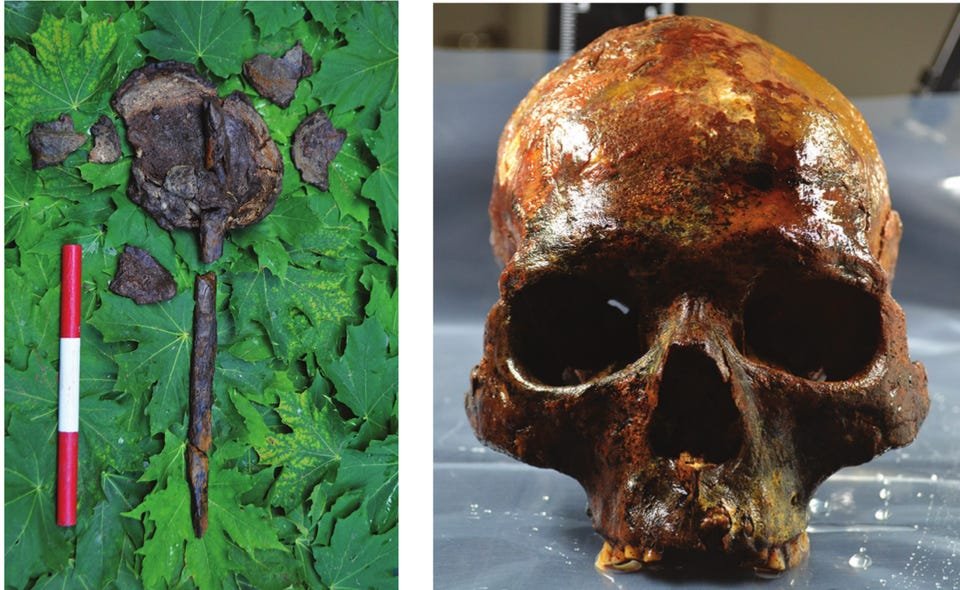A little-known time period in Scandinavian prehistory has recently yielded some of the most extraordinary human remains ever found. On top of a dense layer of stone placed on the bottom of a small lake were pieces of ten humans who lived around 6000 BC. Even stranger than their location in a lake was what had happened to them: most had smashed skulls, and two preserved the remains of long wooden spikes that suggest their heads may have been violently dismembered and displayed.

Writing in the journal Antiquity, Swedish archaeologists Sara Gummesson, Fredrik Hallgren, and Anna Kjellström describe a set of nine adults and one infant skeleton found a few years prior at the site of Kanaljorden in east-central Sweden. A small lake at the site revealed a 12-meter by 14-meter area of packed stone, along with human and animal bones placed on top of the purposefully made structure. Those bones have been carbon dated to 6000-5500 BC, a time when there were at least two settlement areas on the banks nearby, with archaeological material indicating a hunting-and-gathering society.
Animal remains from the lake come from at least seven different species, including wild boar and brown bear. Cut marks on these fauna suggest the animals were being manipulated and dismembered after death, potentially for a reason other than for consumption by humans. The fact that none of the animal bones was burned provides additional support for this hypothesis.
While using animal bones for a ritualistic purpose may not seem too unusual, the archaeologists discovered nine adult human skulls in the same location with surprising injuries. Two were found to be female, four were found to be male, and the others were of indeterminate sex. The tenth person was a full-term infant, but it is not clear if it was stillborn or died soon after birth.
The catalogue of injuries to the adult skulls includes blunt force trauma mostly to the top of the head and to the face, and both of the females and all four males suffered from these traumatic injuries. The women, however, “exhibited evidence of multiple instances of trauma to the back of the head,” Gummesson and colleagues write, “whereas the males exhibited a single traumatic event to the top of the head or to the face.” Three of the males also revealed sharp trauma that occurred around the time of death.
Because the human remains were deposited in a lake with minimal water flow, they are very well preserved, even eight millennia on. One skull contained remnants of brain tissue, which the archaeologists conclude means it was deposited shortly after death. The remarkable preservation conditions also allowed them to recover wooden objects — namely, about 400 intact and fragmentary wooden stakes suggestive of a fence or other partition.

Two of these stakes, however, were found inside skulls. In the image above, “the stake is intact, 25 mm wide and 0.47 m long, of which the last 0.2 m were embedded in the cranium. The opposite end of the stake is pointed,” the archaeologists write. Another stake, while broken, was found partly lodged in a second skull. “In both cases, the stakes were inserted through the foramen magnum,” or the large hole in the skull through which the spinal cord passes, reaching all the way into the inner table of the skull. “These finds show that at least two of the crania were mounted,” Gummesson and colleagues conclude.
The placement of these human heads on a human-made stone structure underwater is unique, the researchers note. But the healed head injuries are not quite as rare: similar ones are seen in other northern European populations from this time period and have been attributed to accidents, interpersonal violence, forced abduction, spousal abuse, socially regulated violence, and warfare. Since “the majority of blunt force trauma at Kanaljorden was located above the hat brim line,” the archaeologists say that this suggests “violence rather than accidental injury.”
The people at Kanaljorden were hunter-gatherers, which makes it unlikely this was a socially stratified society, with the decapitated people being slaves or captives. Rather, the researchers note that “one alternative would be to view the trauma as an outcome of inter-group violence; for example, raiding and warfare – both common occurrences among hunter-gatherers.”
More specifically, the different patterning of injuries in the men and women may be linked to their differing roles and behavior in combat, as Gummesson and colleagues note that “violence to the head is a most effective way of subduing an opponent or victim.” If these individuals were indeed victims of violence from outside their group, the fact that many of them have multiple healed injuries may speak to a life subjected to periodic violent acts.
Neither the cause of death of these people nor the reason for the positioning of two of them on stakes is clear from the archaeological investigation. Given the placement of the stones in the water and the bones on top of that, however, the researchers conclude that “the deposition can be described as being carefully planned and executed, from the construction of the underwater stone packing to the spatially separated depositions of curated human and animal remains.”
While ongoing research into this time and place will undoubtedly yield new information in the future, for now Gummesson and colleagues can say that “the fact that the majority of the individuals showed healed injuries seems to be more than a coincidence and implies that they were specifically chosen for inclusion in the deposition.” Should additional human remains be found similar to those uncovered at Kanaljorden, perhaps our questions about violence in Mesolithic hunter-gatherer societies will one day be answered.